As an Amazon Associate KitchenwareSets.com earns from qualifying purchases.
11 Kitchen Ceiling Ideas That Look Incredibly Expensive
When designing the heart of your home, every detail counts—from the cabinet hardware to the backsplash tile. But what about the space right above your head? Do you, like so many others, pour your entire budget and creative energy into the four walls around you, only to leave the largest uninterrupted surface in the room a blank, forgotten canvas?
This common oversight is a massive missed opportunity. A plain, builder-grade ceiling can leave even the most beautiful kitchen feeling unfinished and generic. It fails to draw the eye upward, missing the chance to create drama, add character, or make the space feel larger and more intentional. It’s the design equivalent of wearing a bespoke suit with scuffed, uninspired shoes.
The kitchen ceiling, often called the “fifth wall,” is a critical design element that can make a kitchen feel larger, brighter, and more luxurious. By using thoughtful design, materials, and lighting, you can transform it from a blank space into a stunning focal point that elevates the entire room. We’ve analyzed hundreds of high-end kitchen designs and consulted with interior experts to distill the secrets that make a space look truly custom and expensive, starting from the top down.
Is Your “Fifth Wall” the Most Overlooked Space in Your Kitchen?
The kitchen ceiling is one of the most impactful yet frequently ignored surfaces in home design. Viewing this “fifth wall” as a design opportunity rather than an afterthought is the secret to unlocking a truly high-end, custom kitchen aesthetic. It’s a vast, open plane that can introduce texture, color, architectural detail, and sophisticated lighting, fundamentally transforming the perception of the entire space from purely functional to intentionally luxurious and inviting.
Too often, the focus of a kitchen remodel remains at eye-level and below—cabinets, countertops, and appliances. While these are crucial, neglecting the ceiling leaves the room feeling incomplete. A strategically designed ceiling does more than just look good; it can solve practical problems. It can define zones in an open-concept layout, hide imperfections, improve acoustics, and create the illusion of height in a smaller kitchen. By integrating the ceiling into your overall design scheme, you create a cohesive, immersive environment that feels professionally curated and significantly more expensive.
We’ve analyzed hundreds of high-end kitchen designs and consulted with interior experts to distill the secrets that make a space look truly custom and expensive, starting from the top down. This guide will reveal how simple shifts in perspective and clever use of materials can turn your kitchen ceiling from a forgotten surface into your home’s most stunning feature.
11 Kitchen Ceiling Ideas That Look Incredibly Expensive (Updated for 2025)
Ready to elevate your kitchen from ordinary to extraordinary? This curated collection is based on architectural principles and current design trends for 2025, ensuring each idea adds both timeless value and modern appeal to your home. We’ve gathered 11 high-impact kitchen ceiling ideas that create a powerful illusion of luxury. “Expensive-looking” doesn’t always require an expensive price tag; it’s about thoughtful design and strategic choices. From timeless architectural details to bold, modern statements, discover how to turn your ceiling into a stunning focal point.
1. Coffered Ceilings for Timeless Architectural Drama
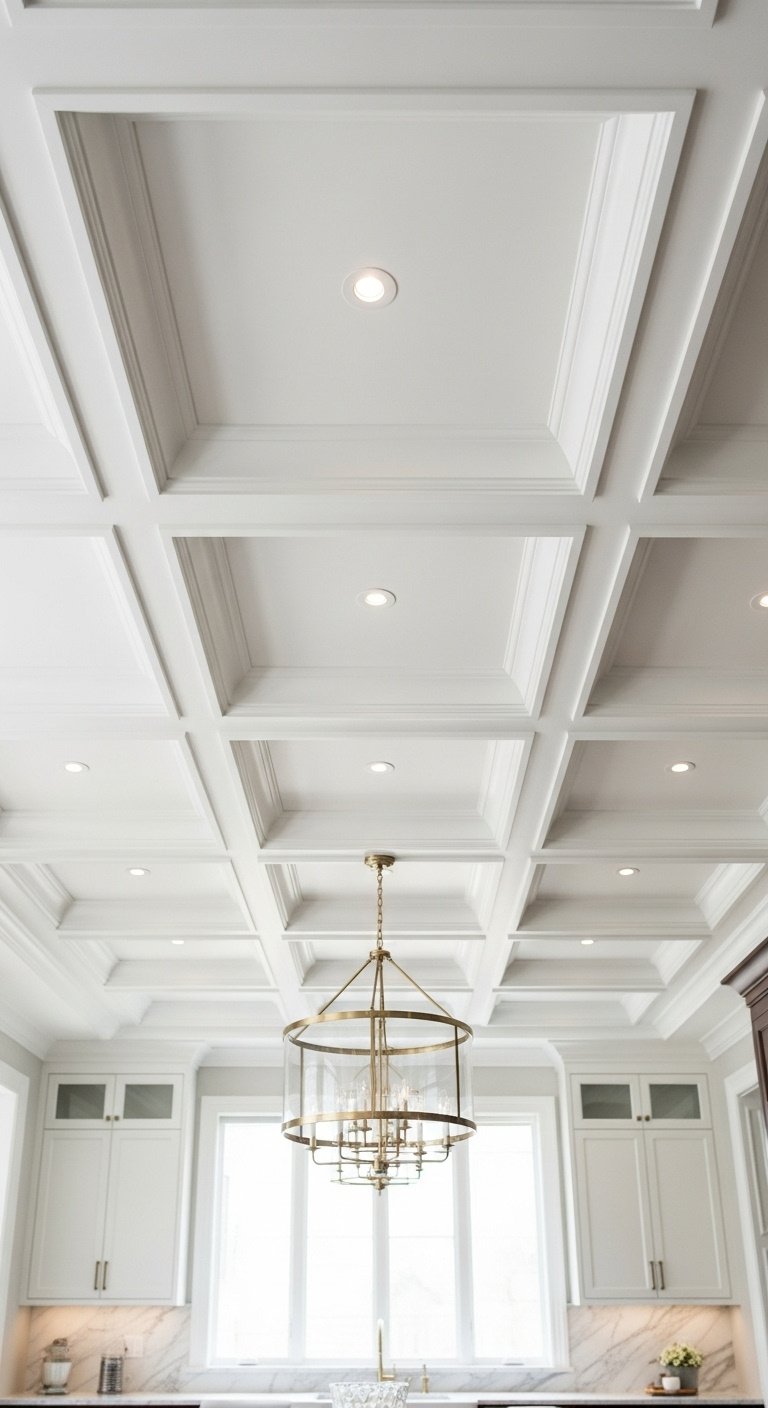
A coffered ceiling is a classic architectural feature consisting of a grid of intersecting beams that create a pattern of recessed panels. This design adds immense depth, dimension, and a sense of traditional grandeur to any kitchen, instantly making it feel custom-built and luxurious.
- Key Materials: Solid wood (oak, teak), moisture-resistant MDF, high-density gypsum board, crown moulding.
- Design & Implementation Tips:
- Assess Height: Best suited for ceilings 9 feet or higher to avoid making the room feel compressed.
- Plan the Grid: Ensure the grid layout is symmetrical and proportional to the room’s dimensions and key features like the kitchen island.
- Integrate Lighting: Plan for recessed lighting within each coffer or a statement chandelier in the center for a dramatic effect.
- Consider Color: Paint the beams and the recessed panels in different shades (e.g., white beams, light grey panels) to enhance the 3D effect.
Pro-Tip: For a more budget-friendly approach, use faux wood beams or MDF to construct the grid. When painted correctly, it’s nearly impossible to tell the difference, giving you the million-dollar look for less.
Save this timeless look to your ‘Dream Kitchen’ board!
2. Tray Ceilings for Subtle, Layered Elegance
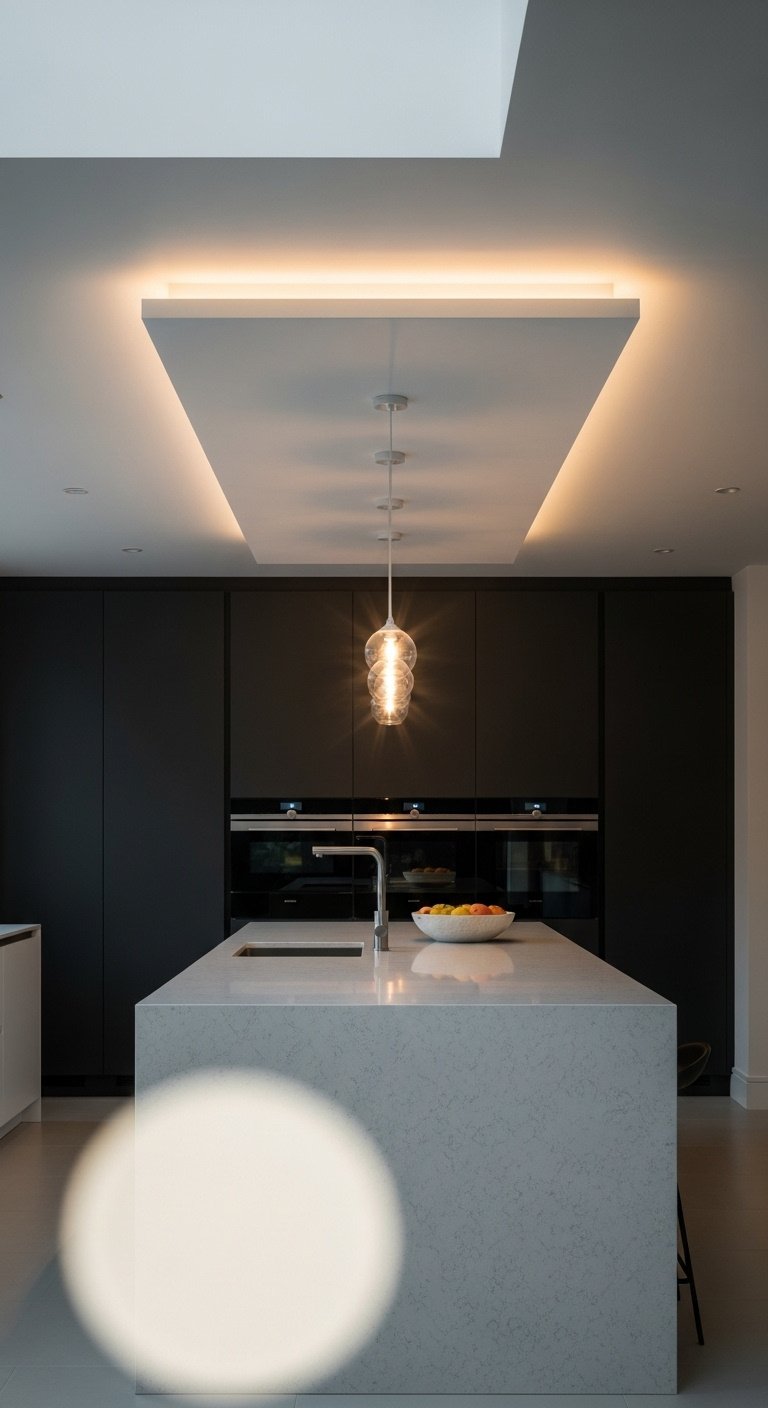
A tray ceiling features a recessed central section, resembling an inverted tray, which adds height and dimension in a more subtle way than a coffered ceiling. This design is perfect for modern kitchens, as it provides an ideal opportunity to incorporate sophisticated ambient lighting.
- Key Materials: Gypsum board (drywall), aluminum framing, wood or laminate mouldings, LED strip lighting.
- Design & Implementation Tips:
- Define a Zone: Use the tray ceiling to define a specific area, such as above the kitchen island or dining area.
- Incorporate Cove Lighting: This is the key to a high-end look. Install hidden LED strip lights along the inner perimeter for a beautiful, indirect glow.
- Add Contrast: Paint the recessed portion of the ceiling a shade or two darker than the surrounding ceiling and walls to create a sense of depth.
- Hang Pendants: The center of the tray is the perfect spot to hang a cluster of pendant lights or a single statement fixture.
Pro-Tip: Use dimmable LED strips for the cove lighting. This allows you to adjust the ambiance from bright and functional for cooking to soft and moody for entertaining.
Pin this chic lighting idea for your modern kitchen!
3. Vaulted Ceilings for an Airy, Expansive Feel
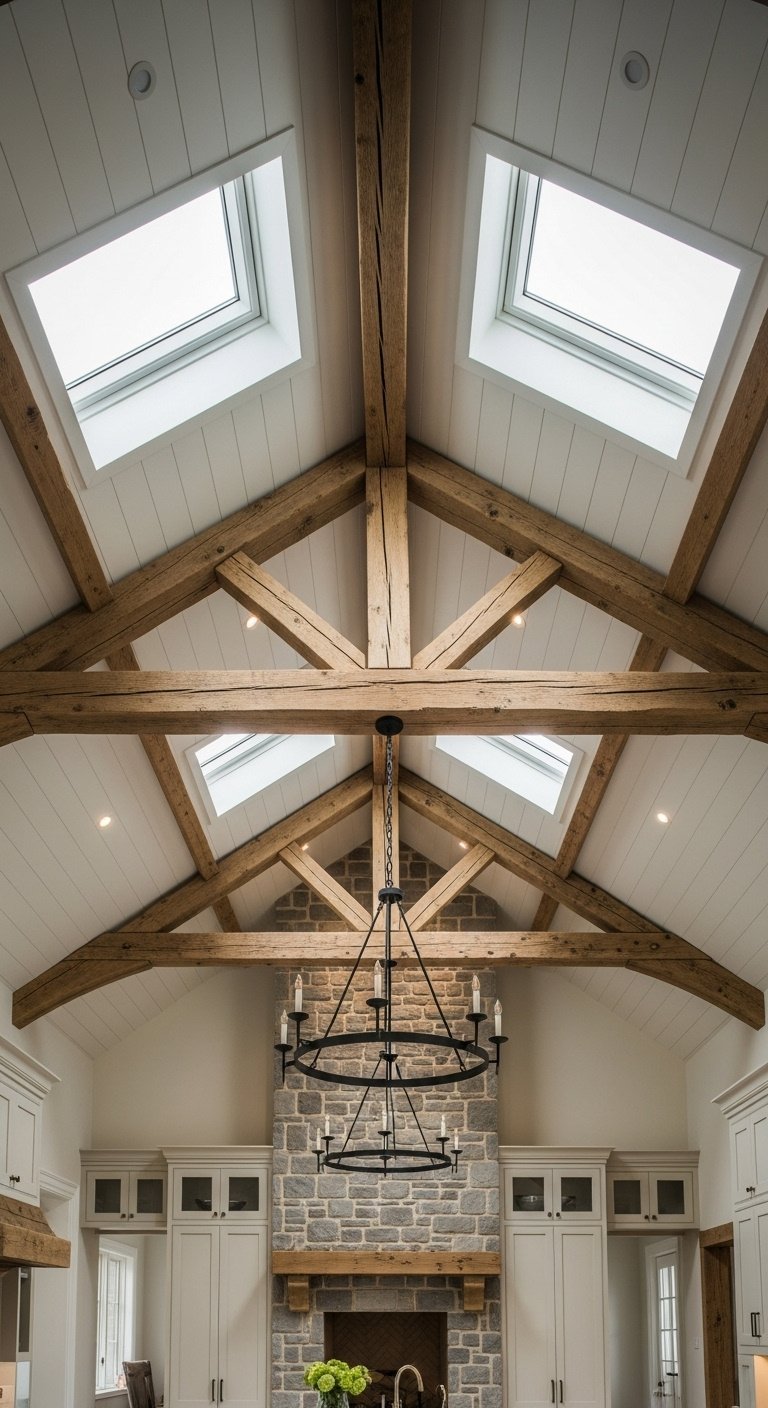
A vaulted ceiling is one that angles up from the walls to a high central peak, following the roof’s pitch. This architectural choice dramatically opens up a kitchen, making it feel incredibly spacious, airy, and grand.
- Key Materials: Exposed timber beams, tongue-and-groove wood planks, gypsum board, skylights.
- Design & Implementation Tips:
- Highlight the Structure: Use contrasting materials to draw attention to the beams and ridges. For example, dark wood beams against a white shiplap ceiling.
- Layer Lighting: Combine natural light from skylights with multiple layers of artificial light. Use long drop pendants to bridge the vertical space and track lighting to illuminate work areas.
- Go Big with Features: The grand scale allows for oversized elements like a large range hood, a massive island, or tall, dramatic windows.
- Manage Sound: Large, open spaces can be noisy. Consider using materials like wood or adding area rugs to help absorb sound.
Lesson Learned: Be mindful of changing light bulbs! Plan for accessible fixtures or invest in long-lasting LEDs to minimize the hassle of maintenance in a high-ceilinged space.
Want this airy, cathedral vibe? Save it for later!
4. Wood Beam-Accented Ceilings for Rustic Warmth
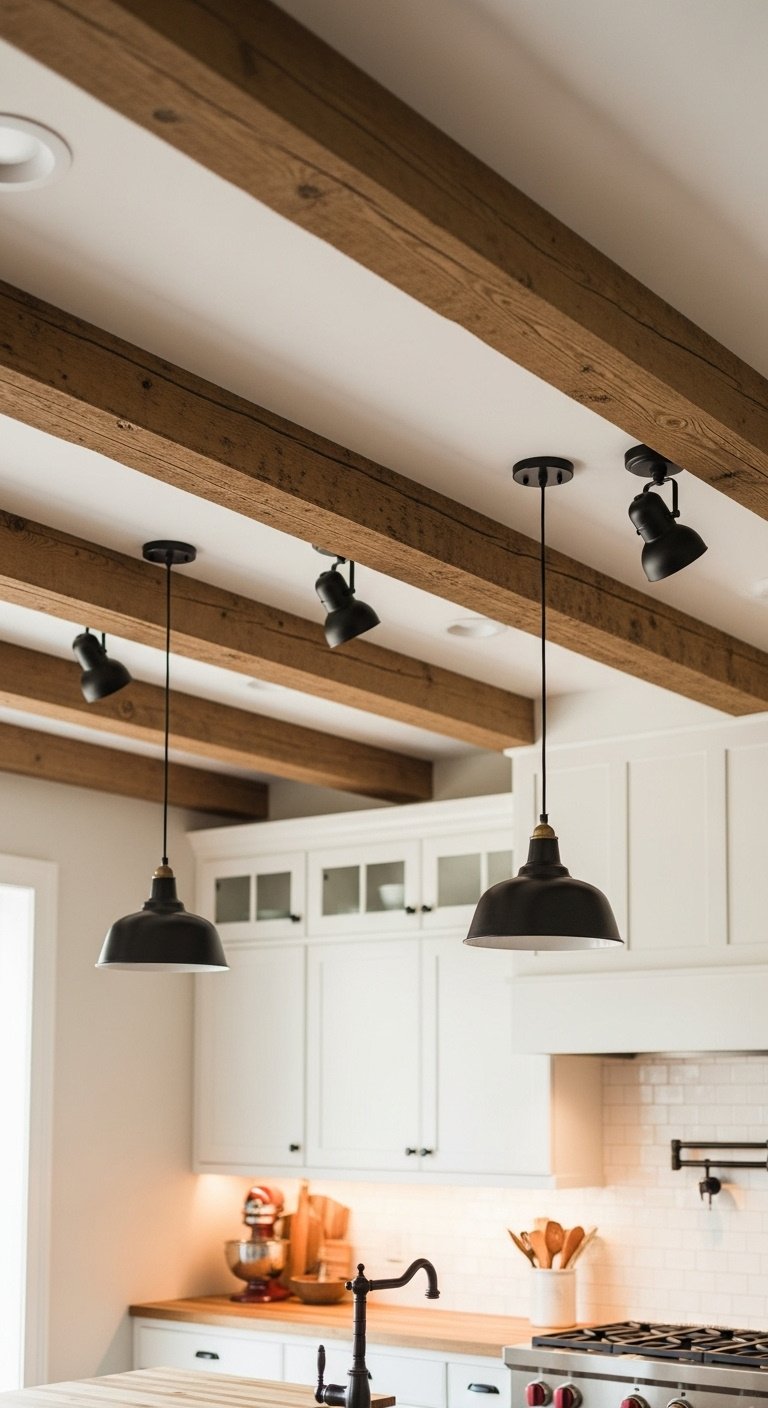
Adding wood beams is a high-impact way to introduce texture, character, and a touch of rustic charm to an otherwise flat ceiling. Whether they are structural or purely decorative, beams draw the eye upward and add architectural interest that feels both cozy and sophisticated.
- Key Materials: Solid timber (oak, ash), reclaimed wood from old barns, lightweight faux wood polyurethane beams.
- Design & Implementation Tips:
- Go Faux for Less: High-density polyurethane faux beams are lightweight, easier to install, and more cost-effective than solid wood, yet they look incredibly realistic.
- Mind the Spacing: Space the beams logically to create a pleasing rhythm. Aligning them with architectural features like windows or doorways can create a sense of order.
- Contrast is Key: For the biggest impact, contrast the beam color with the ceiling color. Dark beams on a white ceiling is a classic, high-impact combination.
- Add Functional Lighting: Mount spotlights or track lighting directly onto the beams to illuminate countertops and work zones.
Pro-Tip: When choosing a stain for your beams, pull a color from another wood element in the room, like your flooring or butcher block island, to create a cohesive and professionally designed look.
Pin this farmhouse ceiling for instant character!
5. Dramatic Painted Ceilings for a Bold Statement
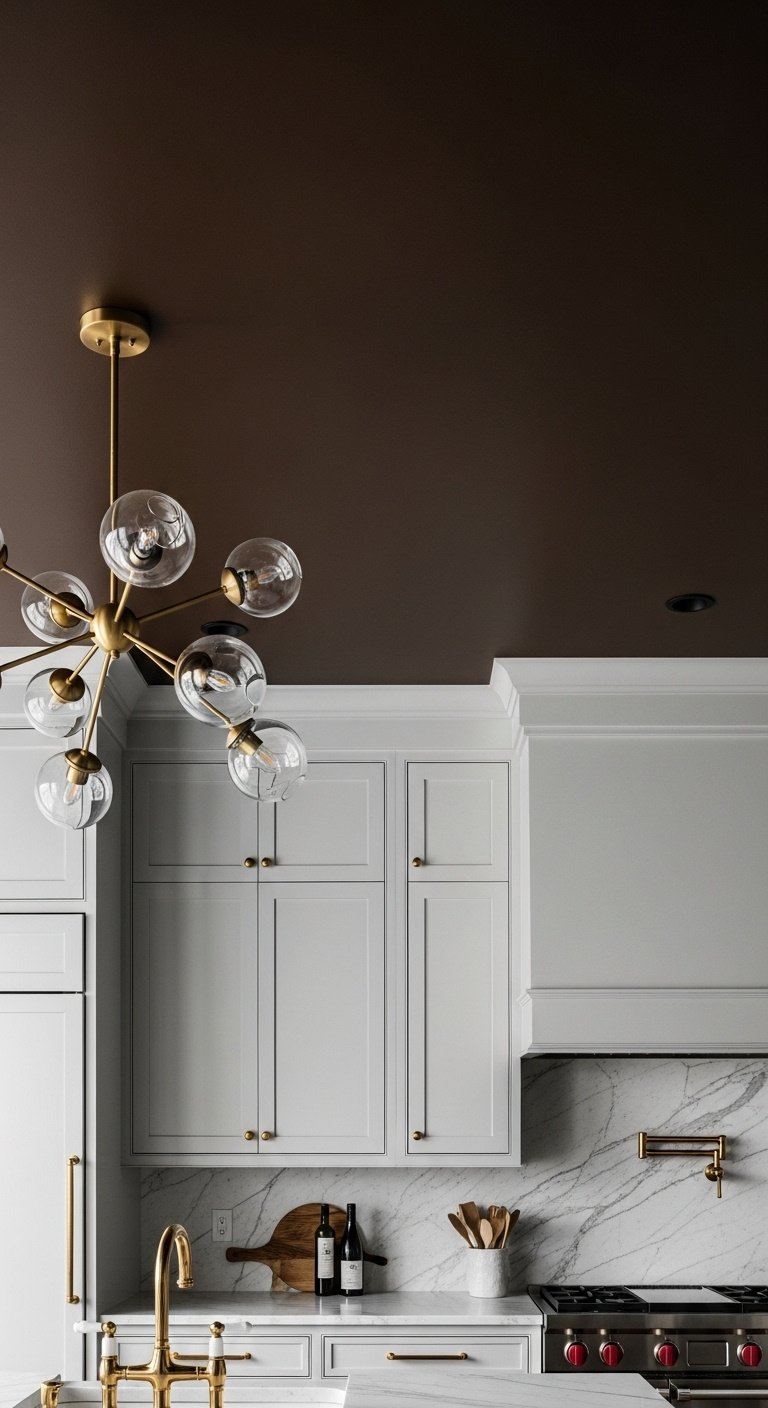
Painting your ceiling is the most affordable yet dramatically transformative design choice you can make. By treating the ceiling as an accent wall, you can add depth, create a specific mood, and make your kitchen look like it was styled by a professional designer.
- Key Materials: High-quality interior paint, primer, painter’s tape, rollers, brushes.
- Design & Implementation Tips:
- Choose the Right Sheen: A matte or flat finish hides imperfections and creates a velvety, luxurious look. An eggshell finish offers slight sheen and better durability for cleaning.
- Create a Cocoon: In a kitchen with ample natural light, painting the ceiling a dark color (like charcoal, navy, or deep green) can create a cozy, intimate, and incredibly sophisticated atmosphere.
- Extend the Wall Color: For lower ceilings, painting the ceiling the same color as the walls can blur the lines and make the room feel taller.
- Don’t Forget Trim: For a truly custom look, paint the crown molding the same color as the ceiling.
Lesson Learned: Always get a sample pot and paint a large swatch on your ceiling before committing. The way light hits a horizontal surface is very different from a wall, so the color may look completely different than you expect.
Feeling bold? Save this high-contrast ceiling idea!
6. Wallpapered Ceilings for Unexpected Pattern and Texture
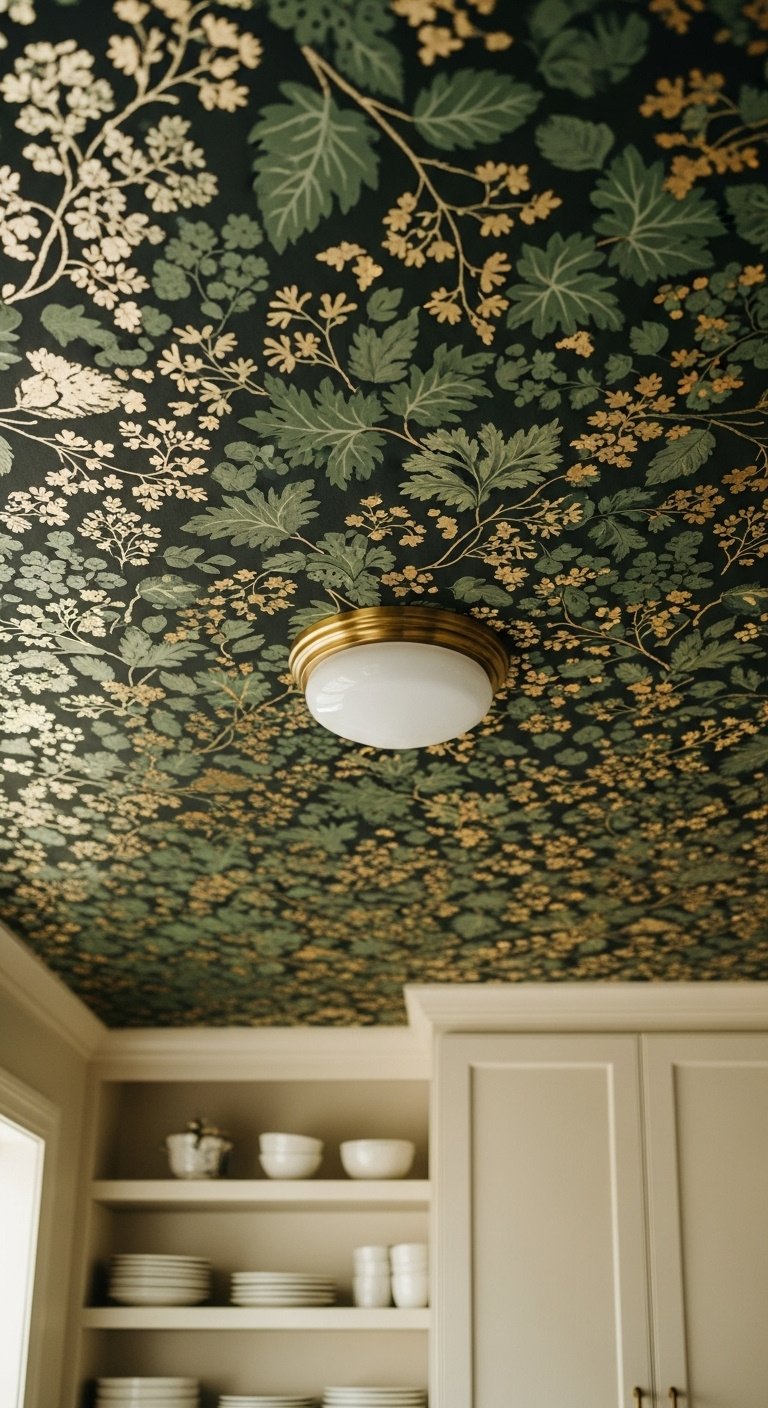
Applying wallpaper to the ceiling is a bold, unexpected design move that adds instant personality, pattern, and texture. This “jewel-box” effect makes a kitchen feel special and highly customized, injecting a dose of high-end designer flair.
- Key Materials: Moisture-resistant or vinyl wallpaper, wallpaper adhesive, smoothing tool, utility knife.
- Design & Implementation Tips:
- Choose a Durable Type: Select a vinyl or “scrubbable” wallpaper that can withstand the moisture and occasional grease of a kitchen environment.
- Start Small: If you’re hesitant, try wallpapering a smaller, defined ceiling area, like in a breakfast nook or over a butler’s pantry.
- Scale the Pattern: In a small kitchen, a large-scale pattern can actually make the space feel bigger and more grand. In a large kitchen, a smaller, more intricate pattern can add texture.
- Keep Lighting Simple: Opt for flush-mount or simple semi-flush-mount lights that won’t compete with the wallpaper pattern for attention.
Pro-Tip: For an easier and less permanent application, use peel-and-stick wallpaper. It’s a fantastic option for renters or for those who like to change their decor frequently.
Add this designer touch to your ‘Kitchen Inspo’ board!
7. Pressed Metal & Tin Ceilings for Vintage Glamour
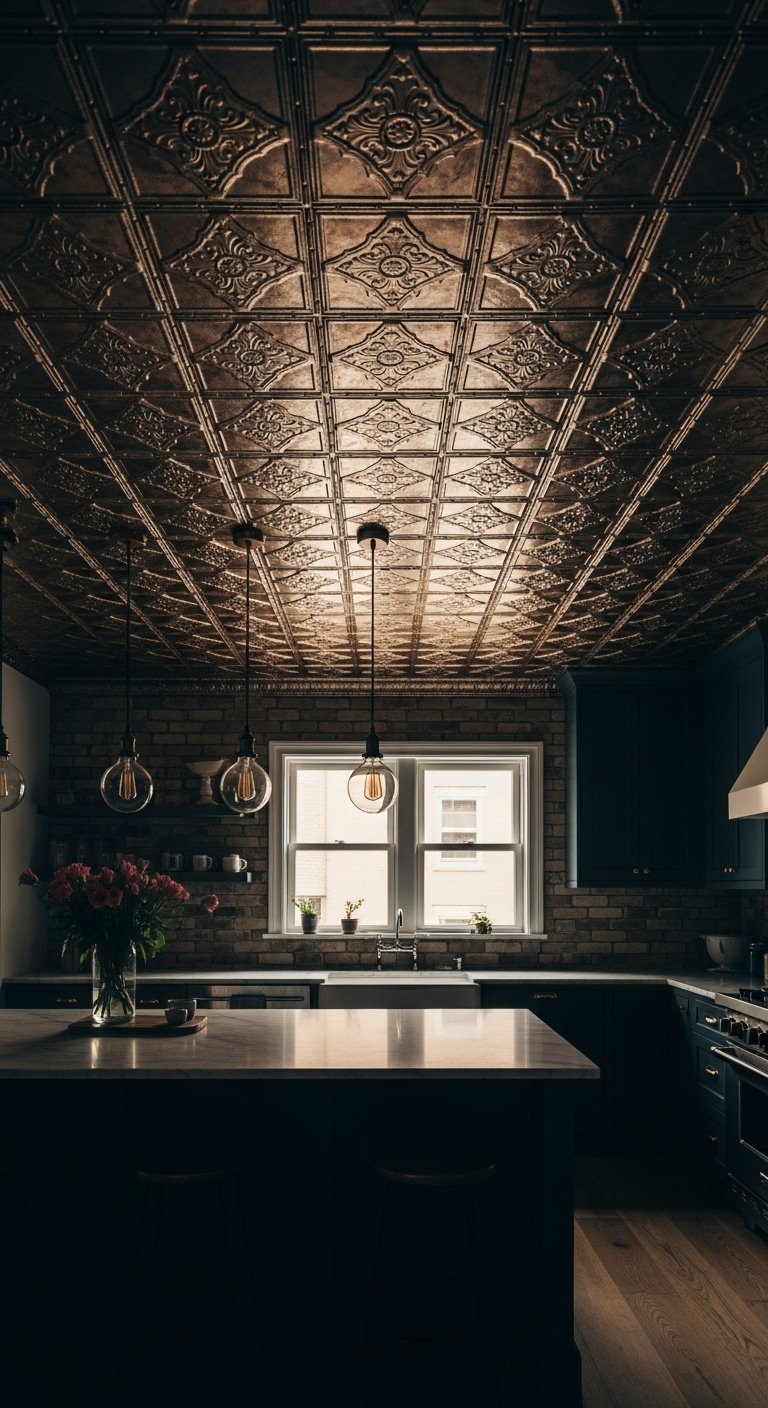
A pressed metal or tin ceiling is a surface covered with decorative, embossed metal tiles, adding rich texture, intricate patterns, and a touch of vintage charm. This style reflects light beautifully and brings a unique, glamorous feel that works in styles from industrial to farmhouse.
- Key Materials: Tin-plated steel tiles, aluminum tiles, faux tin PVC tiles, adhesive, cone-head nails.
- Design & Implementation Tips:
- Consider Faux Tin: Modern PVC ceiling tiles offer the same intricate look as real tin but are lightweight, rust-proof, and much easier to cut and install.
- Match the Finish to Your Fixtures: Create a cohesive look by choosing a metal finish (e.g., copper, brushed nickel, aged brass) that complements your cabinet hardware and faucets.
- Frame It Out: For a high-end look on a budget, install tin tiles only in a central section of the ceiling (like over the island) and frame it with simple wood molding.
- Clean with Care: Gently wipe with a mild detergent. Avoid abrasive cleaners that could scratch the finish.
Pro-Tip: Before installation, lay out your tiles on the floor to get the pattern centered and symmetrical in the room. This planning step is crucial and will save you from major headaches later.
Get this vintage industrial look! Pin it now.
8. Skylight Ceilings to Flood the Space with Natural Light
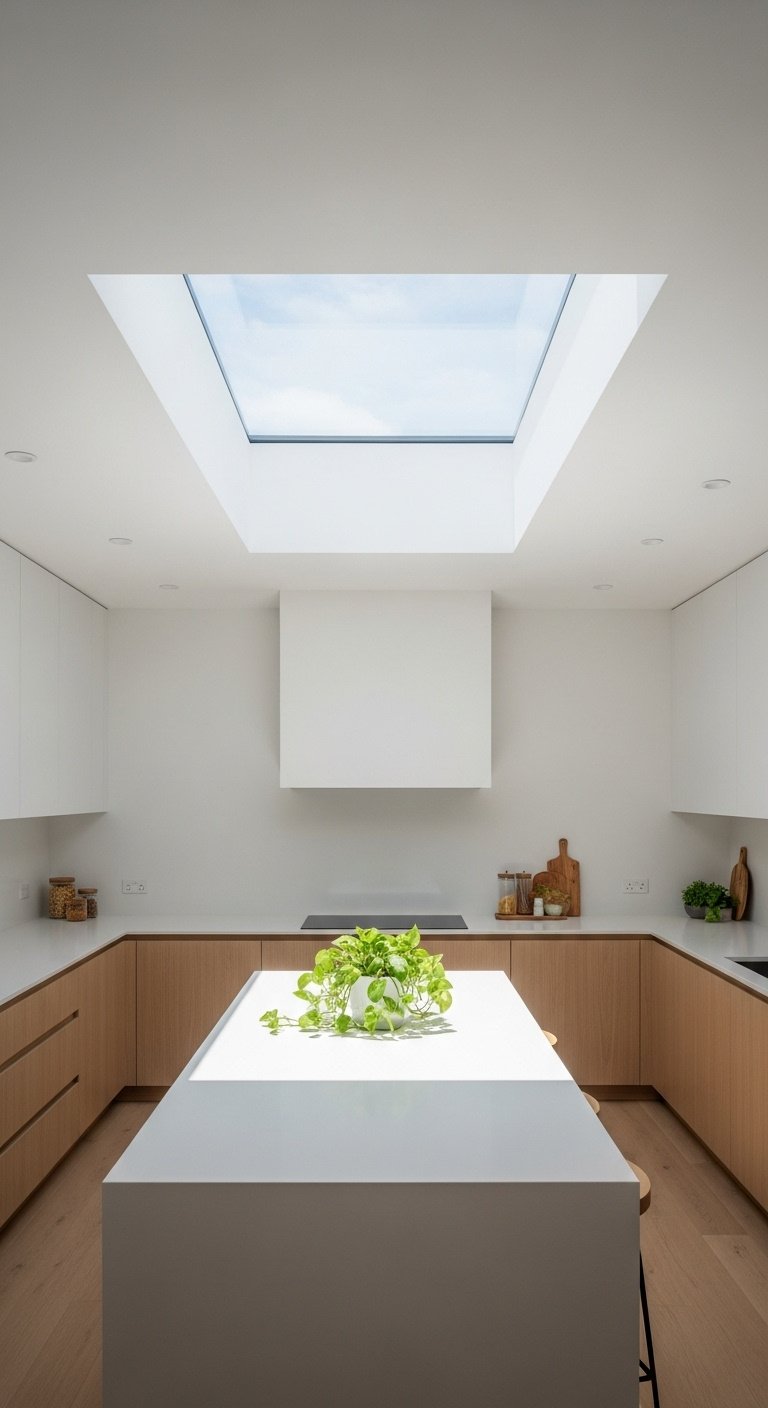
Adding a skylight is a way to integrate a “window” directly into your ceiling, flooding the kitchen with natural light. This is the ultimate luxury, making a space feel larger, more open, and constantly connected to the outdoors, which can significantly reduce the need for artificial lighting during the day.
- Key Materials: Skylight unit (glass or acrylic), flashing kit, interior finishing materials (drywall, paint).
- Design & Implementation Tips:
- Strategic Placement: Install skylights over high-traffic work areas like the kitchen island or sink to maximize functional daylight.
- Consider a Ventilating Model: A skylight that opens can be a huge asset in a kitchen, helping to vent heat, steam, and cooking odors.
- Add Blinds: For intense, direct sunlight, consider adding remote-controlled blinds that can be closed during the hottest parts of the day to manage heat and glare.
- Professional Installation is Key: This is not a typical DIY project. Proper installation and flashing are critical to prevent leaks, so hiring a certified professional is highly recommended.
Lesson Learned: Remember to factor in the orientation of your house. A north-facing skylight will provide soft, consistent light, while a south-facing one will provide intense, direct light and heat.
Let the light in! Save this bright and airy kitchen idea.
9. Decorative Gypsum Moulding for Classic Sophistication
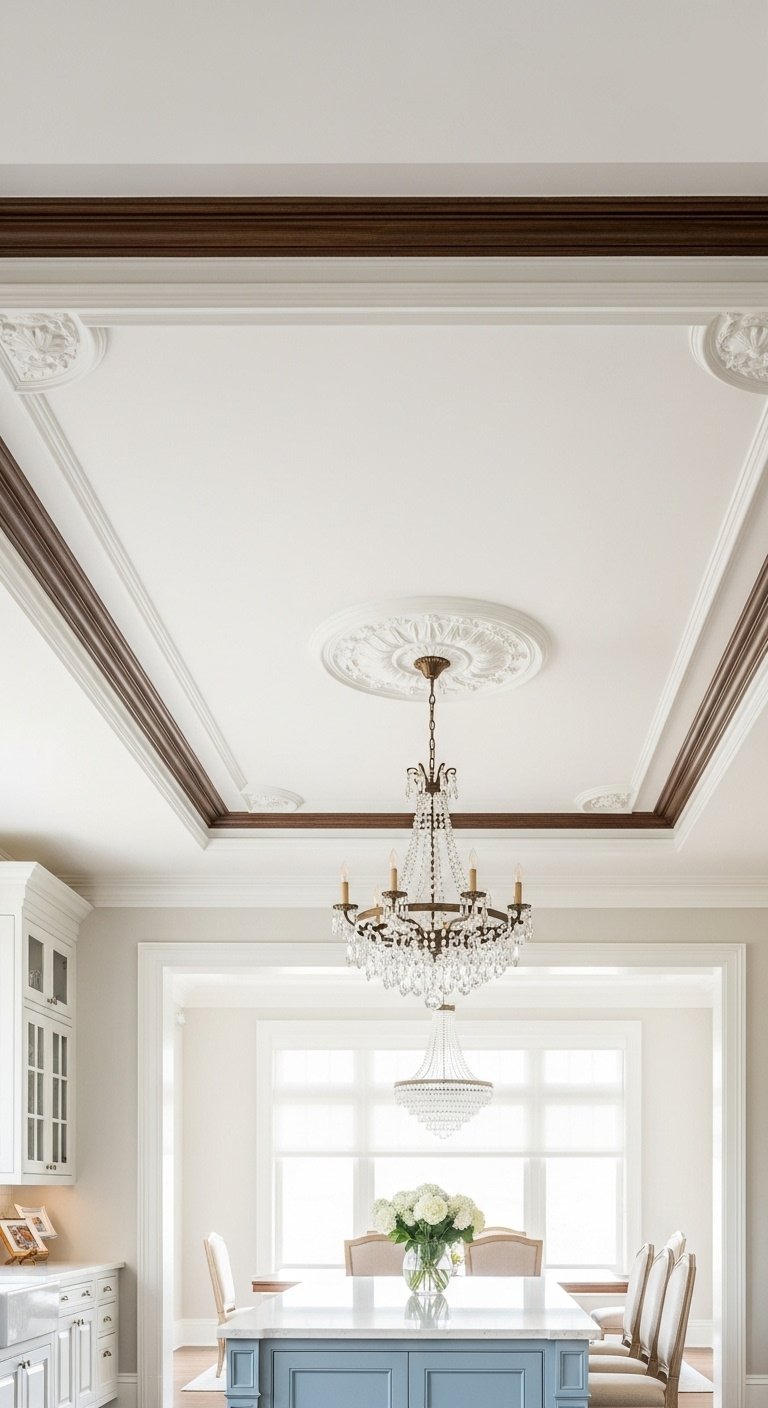
Using decorative gypsum or POP (Plaster of Paris) moulding is a method of applying ornate, pre-formed shapes like borders, cornices, and medallions to a flat ceiling. This technique adds a layer of classic, European-inspired sophistication and architectural detail without requiring major structural changes.
- Key Materials: Plaster of Paris (POP), Glass Reinforced Gypsum (GRG), lightweight polyurethane or fiber mouldings, adhesive.
- Design & Implementation Tips:
- Use Lightweight Options: Modern polyurethane mouldings are much lighter and easier to install than traditional plaster, making this a more DIY-friendly project.
- Create a Medallion Focus: A ceiling medallion is a classic way to draw attention to a beautiful light fixture like a chandelier over an island or dining table.
- Paint for a Seamless Look: Paint the mouldings the exact same color and sheen as the rest of the ceiling to make them look like an integrated, custom architectural feature.
- Layer for Depth: Create a look similar to a tray ceiling by installing multiple layers of flat stock and crown moulding to build up a decorative border.
Pro-Tip: Use a laser level to ensure all your moulding lines are perfectly straight and level before you begin adhering them to the ceiling. A slightly crooked line will be very noticeable.
Add a touch of classic elegance. Pin this moulding idea!
10. Stretch Ceilings for an Ultra-Modern, Flawless Finish
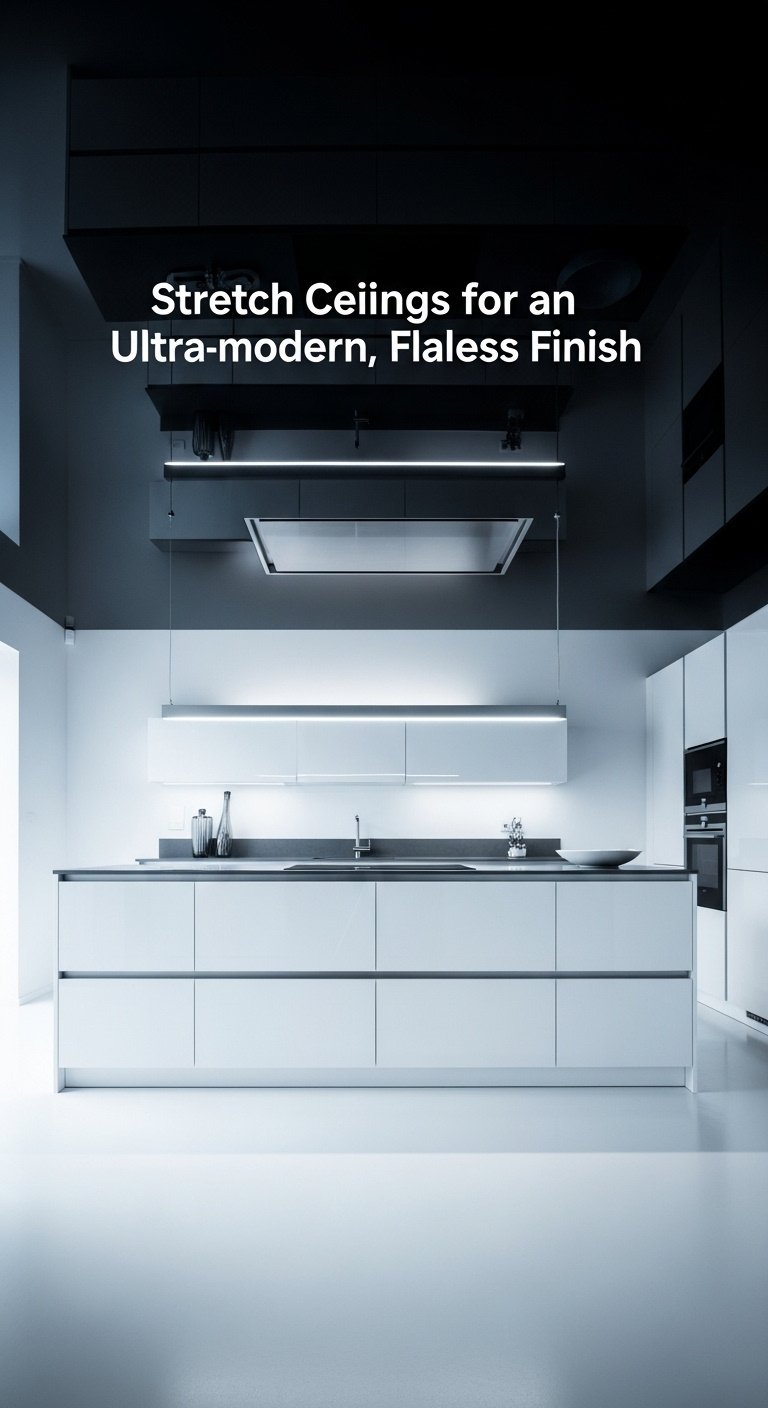
A stretch ceiling is a modern system consisting of a lightweight membrane (typically PVC) that is stretched and secured into a perimeter track. The result is a perfectly smooth, flawless surface that can be high-gloss, matte, or even printed, offering a sleek, futuristic look that is impossible to achieve with drywall.
- Key Materials: Lacquered PVC film or satin-finish polyester fabric, aluminum perimeter track.
- Design & Implementation Tips:
- Choose the Right Finish: A high-gloss or lacquered finish creates a dramatic, mirror-like effect that makes a space feel taller and larger. A matte or satin finish provides a perfectly smooth, flawless surface without the reflection.
- Consider Backlighting: The material can be translucent, allowing you to install LED panels behind it to turn the entire ceiling into a giant, soft light source.
- Hide Imperfections: This is an excellent solution for covering old, damaged plaster or popcorn ceilings without the mess of demolition.
- Hire a Specialist: Installation of stretch ceilings requires special tools and training. This is a job for a certified professional, not a DIY project.
Pro-Tip: Stretch ceilings are waterproof and easy to clean, making them exceptionally practical for a kitchen environment. They can protect the structure above from moisture and are simple to wipe down.
Love a sleek, modern look? Pin this futuristic ceiling!
11. Integrated Lighting Designs as a Sculptural Feature
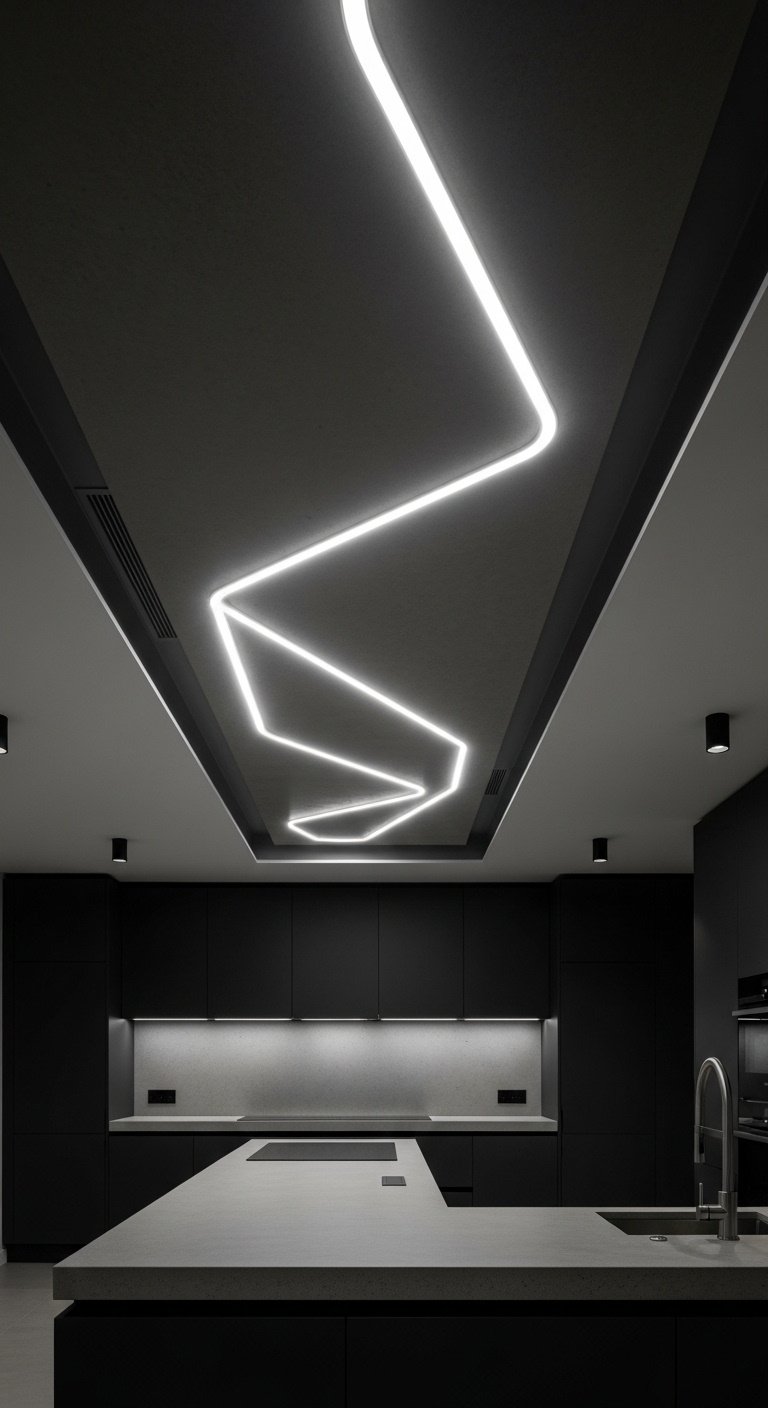
This approach involves treating the lighting fixtures not as add-ons but as an integral, sculptural part of the ceiling design itself. Instead of just placing pot lights, you create channels, coves, and patterns with light, turning illumination into a form of architectural art.
- Key Materials: LED strip lights, aluminum channels with diffusers, recessed “canless” LED fixtures, drywall, electrical wiring.
- Design & Implementation Tips:
- Layer Your Lighting: A high-end kitchen uses at least three layers: ambient (overall illumination), task (focused on work areas), and accent (highlighting features). The ceiling is key to all three.
- Create Recessed Channels: For a truly custom look, have your contractor build channels or coves into the drywall to hide LED strips, creating clean lines of light.
- Go Trimless: Use “trimless” or “bezel-less” recessed lights that are plastered directly into the ceiling for a seamless look where the light appears to emerge from a simple hole.
- Plan with an Electrician: Complex integrated lighting designs require careful planning with a qualified electrician to ensure proper wiring, driver placement, and dimmer compatibility.
Lesson Learned: Pay attention to the color temperature (Kelvins) of your LEDs. For a kitchen, a neutral white (3000K-4000K) is often best for task areas, while a warmer white (2700K) can be used for ambient accent lighting to create a cozy feel.
Make your lighting the star! Save this brilliant idea.
@robertmberger Do coffered ceilings add value? #cofferedceiling #kitchendesign #ceiling #ceilingdesign
Key Takeaways: Your Quick Guide to an Expensive-Looking Kitchen Ceiling
- Add Dimension: Ceilings like Coffered and Tray designs add architectural depth and a custom-built feel.
- Play with Light: Skylights offer unbeatable natural light, while Integrated LED Designs and Cove Lighting create a modern, layered ambiance.
- Introduce Texture & Pattern: Wood Beams, Pressed Tin, and Wallpaper are high-impact ways to add character and warmth to a plain ceiling.
- Use Color Boldly: A Dramatic Painted Ceiling is the most budget-friendly way to make a powerful, sophisticated statement.
- Consider Height: High ceilings can handle dramatic features like Vaults and Beams, while lower ceilings benefit from reflective surfaces or designs that draw the eye upward.
People Also Ask About Kitchen Ceiling Ideas
What is the best type of ceiling for a kitchen?
The best type of ceiling depends on your kitchen’s style, height, and your budget. For durability and hygiene, a smooth, easy-to-clean drywall ceiling with semi-gloss paint is a practical choice. For adding architectural character, coffered or beam-accented ceilings are excellent, while tray ceilings with cove lighting offer a modern, luxurious feel. Metal ceiling tiles are also a great option for withstanding heat and steam.
What is the best material to use for a kitchen ceiling?
Drywall (gypsum board) is the most common and versatile material, as it can be painted, plastered, or used as a base for other finishes. Moisture-resistant drywall is highly recommended for kitchen environments. Other excellent materials include wood planks (for warmth), pressed metal tiles (for durability and style), and modern PVC stretch membranes (for a flawless, easy-to-clean surface).
What are the best coverings for an existing kitchen ceiling?
To cover an old or damaged ceiling, lightweight and easy-to-install options are best. Wood-look ceiling planks or beadboard panels can add character and cover imperfections. Faux tin PVC tiles are an excellent way to get a vintage look without the weight and expense of real metal. For a bold statement, a high-quality, scrubbable wallpaper can also be a fantastic choice.
What is the cheapest way to cover a ceiling?
The most budget-friendly way to transform a kitchen ceiling is with paint. A fresh coat of paint in a bright white can make the space feel cleaner and larger. For a more dramatic and stylish change, painting the ceiling a bold, contrasting color is an inexpensive yet high-impact design choice that instantly adds a custom, expensive look.
Final Thoughts
Your kitchen ceiling is so much more than a lid on a room; it’s a canvas of opportunity waiting to be explored. Whether you have a grand budget for reclaimed wood beams or just a can of dramatic paint, giving your “fifth wall” the attention it deserves is the single most effective way to create a kitchen that feels custom, cohesive, and incredibly luxurious. Don’t let this vast surface be an afterthought. Look up, and start envisioning the incredible potential that lies right above your head.
Which of these ideas sparked your imagination the most? Let me know in the comments below
